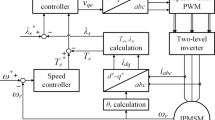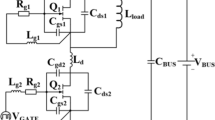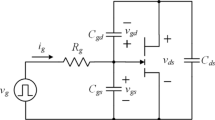Abstract
This paper presents junction temperature estimation method of direct-drive Gallium Nitride (GaN) high electron mobility transistors (HEMTs) in two-level inverters for driving permanent magnet synchronous motor (PMSM). GaN HEMTs exhibit high mobility of electrons due to two-dimensional electron gas (2DEG) formed between GaN layer and AlGaN layer. GaN HEMT is a positive polarity device which has a normally-on characteristic where the switch remains in on-state even in the absence of applied gate voltage. The implementation of normally-off characteristic is necessary to apply GaN HEMTs in power conversion system (PCS). Power losses of GaN HEMTs are generated during the operation of the PCS, which are transformed into thermal energy. The electrical property such as on-resistance, switching energy, and V-I characteristic varies with the junction temperature of GaN HEMTs. Therefore, variation of electrical properties should be considered in power loss profile. An RC Cauer network is utilized to model the thermal behavior. The power losses are converted into junction temperature using the characteristics of materials both internal and external to the GaN HEMTs. The validity of junction temperature estimation method is verified by simulation and experimental results.
















Similar content being viewed by others
References
Zhou Y, He X, Liu S, Hong F, Ren J (2022) Efficiency optimization of variable-frequency controlled power factor correction converters. J Power Electron 22(6):970–980
Han D, Sarlioglu B (2015) Performance evaluation of GaN-based synchronous boost converter under various output voltage, load current, and switching frequency operations. J Power Electron 15(6):1489–1498
Jang J (2022) 600 V p-type gate-doped enhancement mode gallium nitride-based transistros for AC-to-DC power factor-corrected rectifiers operating at 200 kHz. J Power Electron 22(7):1219–1230
Zhang R, Wang Y, Xu H (2021) A novel multi-physics field optimization method for GaN HEMT circuit design. J Power Electron 21(3):616–623
Ravinchandra K, Freddy TKS, Lee J-S, Lee K-B, Mantooth HA, Thiruchelvam V, Xian JIYY (2022) Review of wide band-gap technology: power device, gate driver, and converter design. J Power Electron 22(8):1398–1413
Kazi ZI, Egawa T, Jimbo T, Umeno M (1999) Gain coefficient, quantum efficiency, transparency current density, and internal loss of the AlGaAs–GaAs-based lasers on Si substrate. IEEE Photon Technol Lett 11(12):1563–1565
Lidow A, Strydom J, Rooij MD, Reusch D (2015) GaN transistors for efficient power conversion. Wiley, Hoboken, pp 1–250
Gao J, Li C, Zhang W, Huang S (2021) Permanent magnet temperature estimation of high power density permanent magnet synchronous machines by considering magnetic saturation. J Power Electron 21(12):1804–1811
Kim S-K, Lee K-B (2023) Surface stabilizing speed-tracking control for PMSMs via loop adaptation and order reduction approaches. IEEE Trans Emerg Sel Topics Power Electron 11(1):545–555
Lee H-W, Jang S-J, Lee K-B (2023) Advanced DPWM method for switching loss reduction in isolated DC type dual inverter with open-end winding IPMSM. IEEE Access 11:2700–2710
Gu M, Wang Z, Yu K, Wang X, Cheng M (2021) Interleaved model predictive control for three-level neutral-point-clamped dual three-phase PMSM drives with low switching frequencies. IEEE Trans Power Electron 36(10):11618–11630
Yahaya NZ, Raethar MBK, Awan M (2009) Review on gallium nitride HEMT device technology for high frequency converter applications. J Power Electron 9(1):36–42
Huang X, Li Q, Liu Z, Lee FC (2014) Analytical loss model of high voltage GaN HEMT in cascode configuration. IEEE Trans Power Electron 29(5):2208–2219
Yang Z, Williford PR, Jones EA, Chen J, Wang F, Bala S, Xu J (2021) Factors and considerations for modeling loss of GaN-based inverter. IEEE Trans Power Electron 36(3):3042–3052
Osipov KY, Ostermay I, Brunner F, Wurfl J, Trankle G (2018) Effect of external mechanical stress on DC performance and reliability of integrated E/D GaN HEMTs. IEEE Trans Semicond Manuf 31(4):419–425
Benkhelifa F, Muller S, Polyakov VM, Ambacher O (2015) Normally-off AlGaN/GaN/AlGaN double heterostructure FETs with a thick undoped GaN gate layer. IEEE Electron Device Lett 36(9):905–907
Jin H, Jiang Q, Huang S, Wang X, Wang Y, Ji Z, Dai X, Feng C, Fan J, Wei K, Liu J, Zhong Y, Sun Q, Liu X (2022) An enhancement-mode GaN p-FET with improved breakdown voltage. IEEE Electron Device Lett 43(8):1191–1194
Huang X, Liu Z, Lee FC, Li Q (2015) Characterization and enhancement of high-voltage cascode GaN devices. IEEE Trans Electron Devices 62(2):270–277
Brohlin PL, Ramadass YK, Kaya C (2016) Application note, direct-drive configuration for GaN devices. Texas Instruments, pp 1–7
Xue B, Gong R, Liu J, Zhang Z (2022) A novel inverter topology and its power balancing optimization. J Electr Eng Technol 18(3):2015–2026
Soh J-H, Kang S-W, Kim R-Y (2019) Conduction loss analysis according to variation of resonant parameters in a zero-current switching boost converter. J Electr Eng Technol 14(5):2027–2038
Lee W-C, Kim T-H (2021) Mode-change PWM method for improving efficiency of 3-level T-type PWM converter. J Electr Eng Technol 17(1):437–445
Ma K, Lin J, Zhu Y (2021) Statistical characterization for loss distributions of power semiconductor devices. IEEE Trans Power Electron 36(7):7384–7388
He J, Wei L, Demerdash NAO (2016) Power cycling lifetime improvement of three-level NPC inverters with an improved DPWM method. In: Proceedings of the APEC Conference, pp 2826–2832
Hou R, Shen Y, Zhao H, Hu H, Lu J, Long T (2020) Power loss characterization and modeling for GaN-based hard-switching half-bridges considering dynamic on-state resistance. IEEE Trans Transp Electrification 6(2):540–553
Sarkar A, Deshmukh N, Anand S (2022) Modified PWM scheme to reduce reverse conduction loss in GaN-based independently controlled multiple output flyback converter. IEEE Trans Power Electron 37(11):12968–12972
Sun P, Guo Y, Wu T, Zhao Z, Lai P, Chen Z, Qi L, Cui X (2022) An online junction temperature monitoring correction method for SiC MOSFETs at different parasitic parameters. IEEE Trans Emerg Sel Topics Power Electron 10(5):5007–5018
Shi B, Feng S, Zhang Y, Bai K, Xiao Y, Shi L, Zhu H, Guo C (2019) Junction temperature measurement method for SiC bipolar junction transistor using base-collector voltage drop at low current. IEEE Trans Power Electron 34(10):10136–10142
Zhang Q, Zhang P (2023) A novel junction temperature balance control method for typical three-phase converters based on a hybrid modulation strategy. IEEE Trans Power Electron 38(3):3917–3927
Jeong J-Y, Kwak S (2023) Investigation of loss characteristics in SiC-MOSFET based three-phase converters subject to power cycling and short circuit aging. J Electr Eng Technol 18(4):3049–3059
Zhang Y, Wang H, Wang Z, Yang Y, Blaabjerg F (2019) A simplication method for power device thermal modeling with quantitative error analysis. IEEE Trans Emerg Sel Topics Power Electron 7(3):1649–1658
Ma K, He N, Liserre M, Blaabjerg F (2016) Frequency-domain thermal modeling and characterization of power semiconductor devices. IEEE Trans Power Electron 31(10):7183–7193
Acknowledgements
This work was supported by the Korea Institute of Energy Technology Evaluation and Planning (KETEP) and the Ministry of Trade, Industry & Energy (MOTIE) of the Republic of Korea (No. 20206910100160, No. 20225500000110)
Author information
Authors and Affiliations
Corresponding author
Additional information
Publisher's Note
Springer Nature remains neutral with regard to jurisdictional claims in published maps and institutional affiliations.
Rights and permissions
Springer Nature or its licensor (e.g. a society or other partner) holds exclusive rights to this article under a publishing agreement with the author(s) or other rightsholder(s); author self-archiving of the accepted manuscript version of this article is solely governed by the terms of such publishing agreement and applicable law.
About this article
Cite this article
Lee, IH., Park, SM., Cho, YH. et al. Junction Temperature Estimation of Direct-Drive GaN HEMTs in Two-Level Inverters for Driving PMSM Through Power Loss Analysis. J. Electr. Eng. Technol. 19, 2205–2216 (2024). https://doi.org/10.1007/s42835-023-01688-5
Received:
Revised:
Accepted:
Published:
Issue Date:
DOI: https://doi.org/10.1007/s42835-023-01688-5




